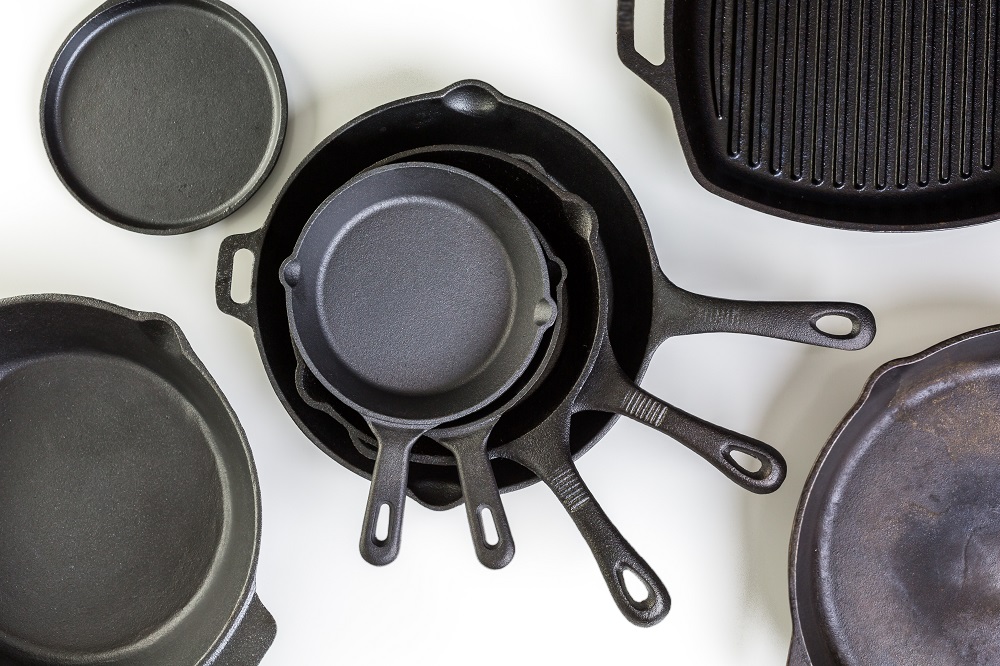If you have previously seasoned your cast iron cookware and have used it for a while, you may have found that your coating may be starting to break down and break off. Or maybe you’ve been using it a lot and have been unsure of how to care for it and have burnt-on build-up that’s starting to leave little burnt black bits on things you cook in it. In these sorts of cases, it’s time to completely strip that skillet back to the original cast-iron!
There’s many, MANY, varying methods for how to do this online, from simple and straightforward to downright industrial! But honestly, I’ve always found that simplest is best, and I like to avoid having to use any dangerous chemicals, any unsafe heat levels, or possible electrocution. I’ll briefly detail some common methods and why I don’t use them, though.
Some people use harsh chemicals like lye or oven cleaner and stick their cast iron in a garbage bag to soak in the chemicals and then wash it. I don’t like this method because I have a small child in the house and two young cats. I also have asthma and both my husband and I have sensitive skin, so for all the above reasons I like to keep the chemicals in the house as gentle as possible. Also, using lye or products containing it can cause nasty chemical burns if you get them on your skin, and also won’t take rust off any cast iron anyway.
I’ve seen a few sites and heard more than one person recommend either using the self-cleaning function on your oven, or throwing the cast iron cookware into the bed of coals in a fire. I don’t recommend this practice of cleaning your cast iron because at these heat levels you can actually warp your cookware or do permanent heat damage! Also, if you’re using the self-cleaning function on your oven, and you do have a greasy burnt on build-up, you’re likely to have some nasty fumes in your home.
Lastly, we have electrolysis which, obviously, involves electricity. I don’t need to tell you how dangerous it is to mess around with electricity, and even something as low as 12V is dangerous in certain circumstances, especially those involving water. This method involves submerging your cast iron in water, along with some washing soda, another piece of metal that all the coating and rust off your cookware will stick to, and hooking it up to an electrical source. I strongly recommend against this method, there are MUCH safer ways of cleaning and restoring your cast iron cookware.
So how do we clean off old coating or cooked on yuckiness? As with almost ANY household cleaning question, the safe and simple answer is VINEGAR!!! Honestly, the amount of scrub hours I’ve put in in my life with various, stinky, eye watering products when vinegar and a good soak is actually the better method is… ugh!
In the near future I’m going to do a collection of my favorite ways to use vinegar as a household cleaner, but for cast iron it’s truly this simple.
Submerge your cast iron in white cleaning vinegar (it’s the double-strength stuff at the supermarket) for 24 hours, then give it a good scrub with steel wool and rinse well. If there’s any schmutz left on your cookware, back into the vinegar for another 24 hours and do it again! This method is great because whilst vinegar is an acid, it’s not so acidic as to be dangerous on the skin, or bad to wash down the drain. It will also remove not only the previous seasoning, but any rust that may be on your piece of cast iron as well! Once it’s clean pop it into a 230C or 450F oven for 45 minutes to COMPLETELY dry it off, it’s very important that no moisture remains on your cast iron when you go to season it.
Keep in mind that the cast iron is now completely raw and will need to be seasoned right after you’ve properly dried it or it will begin to rust immediately.
That’s it! Now you can get started on seasoning and finally cooking with your lovely cast iron cookware.

